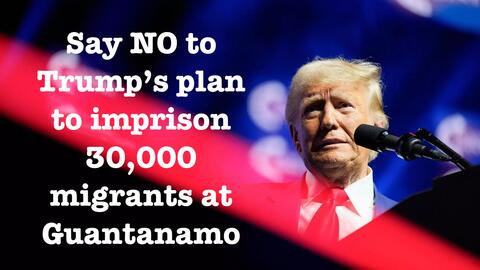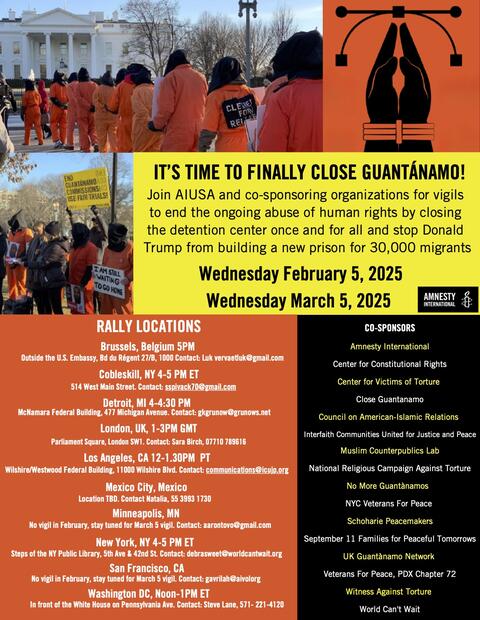Monthly Close Guantánamo Vigils Resume Amidst Trump’s Chilling Promise to Expand a Neighboring Facility to Hold 30,000 Migrants

Our poster calling for resistance to Donald Trump's plan to expand an existing migrant detention facility at Guantánamo to hold 30,000 migrants.
If you can, please make a donation to support our work throughout 2025. If you can become a monthly sustainer, that will be particularly appreciated. Tick the box marked, "Make this a monthly donation," and insert the amount you wish to donate.
By Andy Worthington, February 3, 2025
Last Wednesday, I was preparing a new article looking back on our work over the last 13 years, and especially for the last four years under the Biden presidency, thanking our supporters, and anticipating what might happen with the prison under Donald Trump, when, suddenly, Trump himself shocked us all by announcing that he had just issued a new executive order, "Expanding Migrant Operations Center at Naval Station Guantánamo Bay to Full Capacity," to expand an existing Migrant Operations Center at the naval base, where the "war on terror" prison is located, "to provide additional detention space for high-priority criminal aliens unlawfully present in the United States," as part of his intention to "halt the border invasion, dismantle criminal cartels, and restore national sovereignty."
As a result, I’ve provided an update on our home page instead, with links to examples of the persistence of our efforts to highlight the continuing injustices of the "war on terror" prison — via the release of 15 prisoners before Biden left office, the importance of our ongoing photo campaign marking ever 100 days of the prison’s existence, and the global vigils for the prison’s closure on January 11, the 23rd anniversary of its opening, as well as other events that took place, including a New America panel discussion with myself and our other co-founder, Tom Wilner.
I’m also pleased to announce that the monthly coordinated global vigils for Guantánamo’s closure, which I initiated two years ago, are continuing this Wednesday, February 5, when campaigners around the world will be highlighting the ongoing plight of the 15 men still held, but we will, of course, also be highlighting Trump’s executive order, which is just one small part of a fundamentally disgraceful and sweepingly racist policy of demonizing 13.3 million undocumented migrants currently living and working and paying taxes on the U.S. mainland as criminals, or even as "terrorists," and seeking to deport as many of them as possible.

Announcing his executive order, Trump claimed that the expanded migrant detention facility was intended to house 30,000 migrants, stating, "We have 30,000 beds in Guantánamo to detain the worst criminal illegal aliens threatening the American people."
The history of the Guantánamo Migrant Operations Center
As so often with Trump, the reality regarding the existing Migrant Operations Center is a far cry from his claims. Although such a facility has existed at Guantánamo since the early 1990s, when it was used to hold Haitians and Cubans who were seized fleeing on boats to the U.S. mainland to prevent them from claiming asylum on U.S. soil, it’s nothing short of a lie to claim that there are 30,000 beds there.
As Vince Warren, the executive director of the New York-based Center for Constitutional Rights, told NPR, reports from migrants who have been held there confirm that "there haven't been 30,000 beds" at the facility "in decades." He added, "The facility is decrepit. It's been falling apart. It's in disrepair."
At its peak, under President Bush Sr. and President Clinton, thousands of migrants were detained in the Migrant Operations Center, although it was the subject of a number of damning reports about the abhorrent conditions the migrants endured. As the National Immigrant Justice Center explained, "Asylum seekers were housed in tents covered in garbage bags, which barely protected them from the rain, and enclosed by barbed wire fencing. They were forced to eat spoiled and sometimes maggot-filled food in extreme heat."
By 1996, the numbers of those held had diminished significantly, and, although it has continued in use ever since, it has rarely held more than a few dozen migrants at any time. Conditions, however, have continued to be deplorable, and have included, via the migrant center’s private contractors, stark echoes of the dehumanization of prisoners at Guantánamo, with reports that the work there requires the guards to escort migrants "using proper security measures with black-out goggles and in vehicles with black-out windows for overall facility security and to ensure inability to identify protected migrants."
In September 2024, in a report entitled, "Offshoring Human Rights: Detention of Refugees at Guantánamo Bay," IRAP (the International Refugee Assistance Project) described a facility where, as stated in the report’s executive summary, those held are "detained indefinitely in prison-like conditions without access to the outside world and trapped in a punitive system operated by the Department of Homeland Security (DHS) and of State (DOS), the International Organization for Migration (IOM), and other private contractors, with little to no transparency or accountability."
As the executive summary further explained, "Former IRAP clients, other detained refugees, and former staff at the GMOC [Guantánamo Migrant Operations Center] describe the dilapidated building with mold and sewage issues, where families with young children are housed alongside single adults. They are denied confidential phone calls, even with their attorneys, and punished if they dare share accounts of mistreatment. Refugees are regularly confined to their rooms for weeks at a time. And although the GMOC detains traumatized children, there are no educational services or pediatric psychiatric care provided to them."
The summary added, "These refugees are forced to endure this treatment until a third country agrees to accept them for resettlement, even if they have family in the United States. And the process can take years unless they 'choose' to return to the persecution they fled."
Cynical efforts to compare the "war on migrants" with the "war on terror"
As part of a push by the Trump administration to deliberately draw analogies with the "war on terror" prison, Homeland Security Secretary Kristi Noem told CNN that the new migrant detention center could be used to detain people who she described as "the worst of the worst," echoing Donald Rumsfeld’s notorious — and false — description of the men held in George W. Bush’s "war on terror" prison when it opened in 2002.
On Sunday, Trump’s border tzar, Tom Homan, reprised Noem’s language, telling Fox News, "The worst of the worst need to go to Guantánamo Bay. We’ve had a migrant processing center there for decades … We’re going to expand it a lot."
As just part of Trump’s racist and alarmingly hysterical "war" on migrants, the Guantánamo proposal, and the executive order, are part of a blizzard of executive orders and proclamations that Trump signed as soon as he took office, in which he suggested that the U.S. faced an "invasion" on its southern border, declared a "national emergency" and ordered the military "to take all appropriate action to assist the Department of Homeland Security in obtaining full operational control of the southern border," as well as also suggesting that a similar and unprecedented threat came via the 13.3 million undocumented migrants in the U.S., who he promised to deport via a mass deportation program.
Trump’s plans are chillingly racist, ignoring studies that "have repeatedly shown that undocumented people commit crimes at a significantly lower rate than U.S.-born citizens," and, if enacted, their economic damage would also be unprecedented. Mass deportation would cost hundreds of billions of dollars to implement, whilst also delivering inestimable damage to the U.S. economy, because of the huge role played in it by migrants.
However, the first steps towards enforcing them are already underway, primarily through the expansion of "expedited removal," a policy first introduced in 1996 to remove the rights to legal support, or any kind of immigration hearing, for certain undocumented migrants, allowing them to be seized and deported within 24 hours.
Mainly used on undocumented migrants who were seized within two weeks of their arrival and within 100 miles of the border, the "expedited removal" policy has now been expanded to encompass the whole of the U.S. mainland.
Under the terms of the Laken Riley Act passed last week (cynically named after a U.S. student murdered by an undocumented migrant, as if to suggest that all 13.3 million undocumented migrants are also potential murderers), the Department of Homeland Security is required "to detain certain non-U.S. nationals (aliens under federal law) who have been arrested for burglary, theft, larceny, or shoplifting," with the Act’s summary adding that DHS "must detain an individual who (1) is unlawfully present in the United States or did not possess the necessary documents when applying for admission; and (2) has been charged with, arrested for, convicted of, or admits to having committed acts that constitute the essential elements of burglary, theft, larceny, or shoplifting." The only constraint on the use of the Act is meant to be that it only applies to those who cannot demonstrate that they have been in the country for more than two years, although in many cases, of course, undocumented migrants may find that difficult to prove.
Resisting Trump's "war on migrants"
The sweeping nature of the new law is genuinely alarming, not just because it so fundamentally cruel and discriminatory, but especially because no conviction is even required, just a "charge" that could, for example, be easily fabricated.
What is unclear at present is the extent to which the Trump administration can use "expedited removal" to bypass the fundamental right of those detained to seek asylum on the basis that they have a credible fear of persecution or ill-treatment (or worse) if they are sent back to their home countries.
Known as non-refoulement, this is a fundamental principle of international law, enshrined in the 1951 Refugee Convention, which forbids the deportation of anyone seeking entry to another country, whether they are described as refugees, asylum seekers or migrants, if, as a result, their "life or freedom would be threatened" on account of "race, religion, nationality, membership of a particular social group or political opinion."
If Trump gets away with a massive expansion of "expedited removal," it is uncertain whether the envisaged expansion of the Guantánamo migrant facility will be required, as ICE (the U.S. Immigration and Customs Enforcement agency) already has 40,000 detention places on the U.S. mainland, to deal with those who are able to challenge the basis of their summary removal.
Trump may have issued his executive order primarily as part on an arsenal of hostility to force his target countries in Central and South America and the Caribbean not to dissent as he loads up military planes to send back their nationals on the flimsiest of bases.
For it to take effect, however, he needs to secure funding from Congress. This may not prove difficult, as he has a majority in both houses of Congress, who may not balk at signing a blank check for what will easily end up costing hundreds of millions, or even billions of dollars. Even so, those detained, rather than those who can be summarily deported by "expedited removal," will have legal rights to challenge the basis of their deportation, and it is unclear what Trump hopes to gain by massively increasing the cost of that process by holding migrants at Guantánamo, where everything ends up costing many hundreds of times what it costs on the mainland.
On this point, the biggest fear is that he is hoping to expand the facility to cater for a category of as yet undefined unreturnable migrants who, at Guantánamo, can much more easily be held indefinitely, as has been the case with the men held in the neighbouring "war on terror" prison for the last 23 years.
For that, however, he would again have to secure Congressional approval, and I can’t help but wonder whether any lawmakers, or the U.S. media, or other representatives of the U.S. establishment would take exception to the creation of a new law that would explicitly endorse holding undocumented migrants at Guantánamo indefinitely on the basis that they pose a direct threat to the U.S. and its security as "invaders" or "terrorists."
It seems unlikely, but in the unjust, cynical, violently racist madness of these times, anything is possible, and in the meantime, as we wait to see what will happen with the proposed expansion of the migrant detention facility, it is hugely important that everyone who opposes the continued existence of the "war on terror" prison at Guantánamo, also opposes every aspect of Trump's sickening "war on migrants" too.




